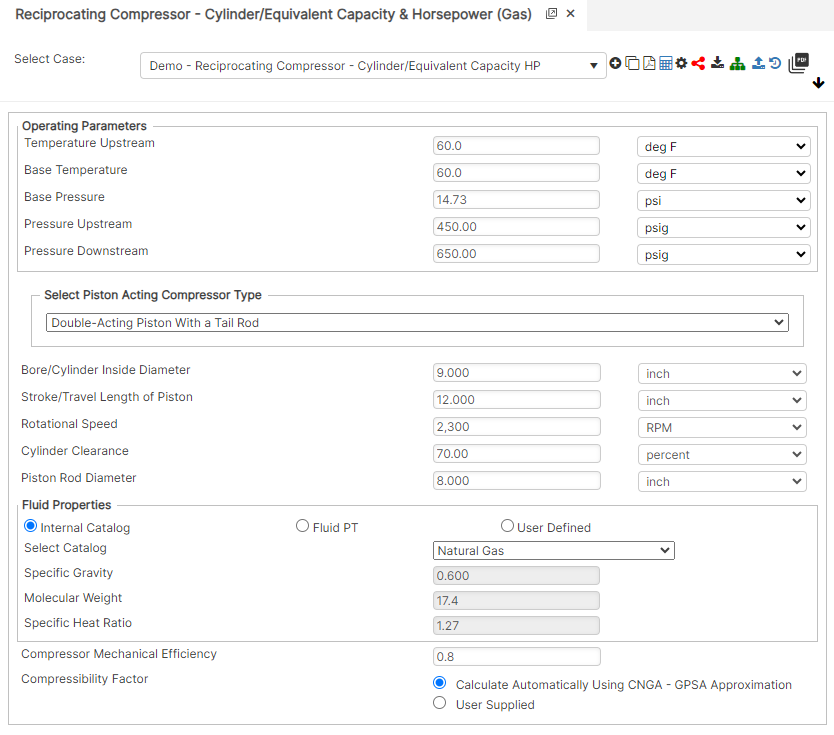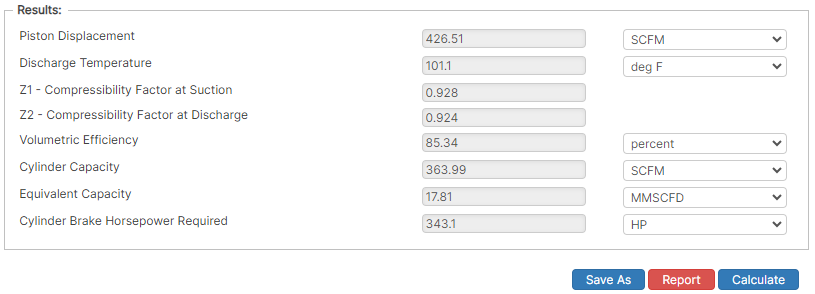Introduction
This application uses a positive displacement compressor model to deliver gases at high pressures. With piston displacement reciprocating compressors, often final outlet temp could be a concern.
Piston Displacement
Single-Acting Piston Compression on the Outer End Only: PD = \frac{sn\pi D^2}{4 \times 1728}
PD = \frac{sn\pi D^2}{4 \times 1728}
Single-Acting Piston Compression on the Crank End Only: PD = \frac{sn\pi (D^2 – d^2)}{4 \times 1728}
PD = \frac{sn\pi (D^2 - d^2)}{4 \times 1728}
Double-Acting Piston Compression (Other than Tail Rod Type): PD = \frac{sn\pi (2D^2 – d^2)}{4 \times 1728}
PD = \frac{sn\pi (2D^2 - d^2)}{4 \times 1728}
Double-Acting Piston Compression (With a Tail Rod): PD = \frac{2sn\pi (D^2 – d^2)}{4 \times 1728}
PD = \frac{2sn\pi (D^2 - d^2)}{4 \times 1728}
Where:
𝑃𝐷 − Piston Displacement (ft3/min)
𝑠 − Stroke (𝑖𝑛)
𝑛 − Rotational Speed (rpm)
𝐷 − Cylinder Inside Diameter (in)
𝑑 − Piston Rod Diameter (in)
Reciprocating Compressor Volumetric Efficiency
VE = 100 – A – L_u – r – C \left[ \frac{Z_s}{Z_d} \left( r^{\frac{1}{k}} \right) – 1 \right]
VE = 100 - A - L_u - r - C \left[ \frac{Z_s}{Z_d} \left( r^{\frac{1}{k}} \right) - 1 \right]
Where:
𝑉𝐸 − Volumetric Efficiency (%)
𝐴 − Effect of Leakage, Losses etc. (%)
𝐿𝑢 − Effect due to Lack of Lubrication (%)
𝑟 − Compression Ratio (𝑃2/𝑃1)
𝐶 − Cylinder Clearance as a Percent of Cylinder Volume (%)
𝑧𝑠 − Compressibility Factor at Suction Conditions
𝑧𝑑 − Compressibility Factor at Discharge Conditions
𝑘 − Adiabatic/Isentropic Exponent (𝑐𝑝/𝑐𝑣)
In practice for normal operation
VE = 96 – r – C \left[ \frac{Z_s}{Z_d} \left( r^{\frac{1}{k}} \right) – 1 \right]
VE = 96 - r - C \left[ \frac{Z_s}{Z_d} \left( r^{\frac{1}{k}} \right) - 1 \right]CNGA/GPSA Compressibility Factor Approximation:
Z=\frac{1}{\left[1+\left(\frac{3.444\times10^5P\times10^{1.785G}}{T_f^{3.825}} \right)\right]}
Z=\frac{1}{\left[1+\left(\frac{3.444\times10^5P\times10^{1.785G}}{T_f^{3.825}} \right)\right]}Where:
𝑍 − Compressibility Factor
𝑃 − Pressure
𝑇𝑓 − Gas Flowing Temperature (°𝑅)
This approximation will produce results sufficiently accurate for preliminary calculations.
Q_{\text{actual}} = PD \frac{VE}{100} \quad [\text{ft}^3/\text{min}] \text{(ACFM)} \~\ Q_{\text{actual}} = PD \cdot VE\frac{P_1}{P_b} \cdot 14.4 \times 10^{-5} \quad [\text{MMCFD}] \~\ Q_{st} = Q_{\text{actual}} \frac{P_1}{P_b}\frac{T_b}{T_1}\frac{Z_b}{Z_1} \quad [\text{MMSCFD}]
Q_{\text{actual}} = PD \frac{VE}{100} \quad [\text{ft}^3/\text{min}] \text{(ACFM)} \\~\\ Q_{\text{actual}} = PD \cdot VE\frac{P_1}{P_b} \cdot 14.4 \times 10^{-5} \quad [\text{MMCFD}] \\~\\ Q_{st} = Q_{\text{actual}} \frac{P_1}{P_b}\frac{T_b}{T_1}\frac{Z_b}{Z_1} \quad [\text{MMSCFD}]
Reciprocating Compressor Horsepower
HP=\frac{144}{33000}\left( \frac{P_1Q}{n}\right)\left(\frac{k}{k-1} \right)\left[ (r)^{\frac{k-1}{k}}-1\right] [HP]
HP=\frac{144}{33000}\left( \frac{P_1Q}{n}\right)\left(\frac{k}{k-1} \right)\left[ (r)^{\frac{k-1}{k}}-1\right] [HP]Where:
𝑄 − Suction Capacity (SCFM)
𝑃1 − Gas Suction Pressure (psi)
𝑛 − Compressor Efficiency
𝑘 = (𝑐𝑝/𝑐𝑣) − Specific Heat Ratio
𝑟 − Compression Ratio (𝑃2/𝑃1)
Ideal Discharge Temperature
T_{2(\text{ideal})} = T_1 \left[ (r)^{\frac{k-1}{k}} – 1 \right]
T_{2(\text{ideal})} = T_1 \left[ (r)^{\frac{k-1}{k}} - 1 \right]
Where:
𝑇2(𝑖𝑑𝑒𝑎𝑙) − Ideal Discharge Temperature (°R)
𝑇1 − Suction Temperature (°R)
𝑟 − Compression Ratio (P2/P1)
𝑘 − 𝐴diabatic/Isentropic Exponent (𝑘=[𝑐𝑝/𝑐𝑣])
Theoretical Discharge Temperature
\Delta T_{\text{ideal}} = T_1 \left[ (r)^{\frac{k-1}{k}} – 1 \right]
\Delta T_{\text{ideal}} = T_1 \left[ (r)^{\frac{k-1}{k}} - 1 \right]
Where:
𝑇2 = 𝑇1+Δ𝑇𝑖𝑑𝑒𝑎𝑙
𝑇2 − Theoretical Discharge Temperature (°R)
Actual Discharge Temperature
\Delta T_{\text{actual}} = T_1 \frac{\left[ (r)^{\frac{k-1}{k}} – 1 \right]}{ {n_a}}
\Delta T_{\text{actual}} = T_1 \frac{\left[ (r)^{\frac{k-1}{k}} - 1 \right]}{ {n_a}}
Where:
𝑇2 = 𝑇1+Δ𝑇𝑎𝑐𝑡𝑢𝑎𝑙
𝑇2 − Actual Discharge Temperature (°R)
𝑛𝑎 − Adiabatic (Isentropic) Efficiency
Case Guide
Part 1: Create Case
- Select the Adiabatic Head application from the Compressor Module
- To create a new case, click the “Add Case” button
- Enter Case Name, Location, Date and any necessary notes.
- Fill out all required Parameters.
- Make sure the values you are inputting are in the correct units.
- Click the CALCULATE button to overview results.
Input Parameters
- Suction Temperature Upstream (°F)
- Base Temperature (°F)
- Base Pressure (psi)
- Suction Pressure Upstream (psig)
- Discharge Pressure Downstream (psig)
- Bore/Cylinder Inside Diameter (in)
- Stroke/Travel Length of Piston (in)
- Rotational Speed (rpm)
- Cylinder Clearance (%)
- Piston Rod Diameter (in)
- Capacity/Required Flow Rate (MMSCFD)
- Gas Specific Gravity (Relative to air)
- Gas Molecular Weight
- Gas Specific Heat Ratio
- Compressor Mechanical Efficiency
- Compressibility Factor

Part 2: Outputs/Reports
- If you need to modify an input parameter, click the CALCULATE button after the change.
- To SAVE, fill out all required case details then click the SAVE button.
- To rename an existing file, click the SAVE As button. Provide all case info then click SAVE.
- To generate a REPORT, click the REPORT button.
- The user may export the Case/Report by clicking the Export to Excel icon.
- To delete a case, click the DELETE icon near the top of the widget.
Results
- Piston Displacement (ft³/min)
- Discharge Temperature (°F)
- Z1 – Compressibility Factor at Suction
- Z2 – Compressibility Factor at Discharge
- Volumetric Efficiency (%)
- Cylinder Capacity (SCFM)
- Equivalent Capacity (MMSCFD)
- Cylinder Brake Horsepower Required (HP)


References
- Engineering Data Book, Volume 1, Gas Processors Suppliers Association, Tenth Edition
- Compressor Station Operation, Book T-2, GEOP, American Gas Association (A.G.A.)
- Compressor Selection and Sizing, Royce N. Brown, Second Edition, Gulf Professional Publishing
